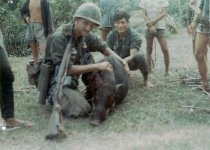Daekar,
If you want a scientific explanation of what and how various projectiles operate in the body, I'd refer you to Gunshot Wounds: Practical Aspects of Firearms, Ballistics, and Forensic Techniques by Vicent DiMaio. While the text is about the damage done to humans it does a good job of explaining the internal ballistics of an expanding projectile in living tissue.
There are two key aspects of the damage done - the wound channel (the actual hole made by the bullet) and the wound cavity (the surrounding tissues destroyed by hydrostatic shock). An expanding bullet generates a substantially larger hydrostatic shock wave than does a pointed projectile. This hydrostatic shock wave, and not the projectile itself, disrupts the surrounding tissue. An FMJ makes a very small wound cavity (save for key-holing or tumbling)
Try an experiment next time you're in the tub with your rubber ducky. Hit the water with the flat of your hand and then poke your hand straight into the water fingers first with as close to the same force as you can. The flat hand strike approximates the energy transfer of the expanded projectile and the knife edge hand the FMJ.
Now, with bullets, especially rifle bullets, they are traveling at such high relative velocities that it doesn't take much expansion to create a devastating wound cavity with very moderate expansion.
The FMJ projectile, that enters ballistically true takes advantage of the natural elasticity of living tissue (the difference between poking an icepick and a hammer through an elastic membrane). When the wound channel collapses back it will almost seal itself in some instances with a sharp projectile. The huge cavitation caused by the blunt projectile leaves a permanent cavity behind.
I am not a hunter either, and would not pretend to actually know the answer to the most humane way to take game animals. I suspect as many die from shock as the actual wound damage, but I don't really know.
If you want a scientific explanation of what and how various projectiles operate in the body, I'd refer you to Gunshot Wounds: Practical Aspects of Firearms, Ballistics, and Forensic Techniques by Vicent DiMaio. While the text is about the damage done to humans it does a good job of explaining the internal ballistics of an expanding projectile in living tissue.
There are two key aspects of the damage done - the wound channel (the actual hole made by the bullet) and the wound cavity (the surrounding tissues destroyed by hydrostatic shock). An expanding bullet generates a substantially larger hydrostatic shock wave than does a pointed projectile. This hydrostatic shock wave, and not the projectile itself, disrupts the surrounding tissue. An FMJ makes a very small wound cavity (save for key-holing or tumbling)
Try an experiment next time you're in the tub with your rubber ducky. Hit the water with the flat of your hand and then poke your hand straight into the water fingers first with as close to the same force as you can. The flat hand strike approximates the energy transfer of the expanded projectile and the knife edge hand the FMJ.
Now, with bullets, especially rifle bullets, they are traveling at such high relative velocities that it doesn't take much expansion to create a devastating wound cavity with very moderate expansion.
The FMJ projectile, that enters ballistically true takes advantage of the natural elasticity of living tissue (the difference between poking an icepick and a hammer through an elastic membrane). When the wound channel collapses back it will almost seal itself in some instances with a sharp projectile. The huge cavitation caused by the blunt projectile leaves a permanent cavity behind.
I am not a hunter either, and would not pretend to actually know the answer to the most humane way to take game animals. I suspect as many die from shock as the actual wound damage, but I don't really know.

